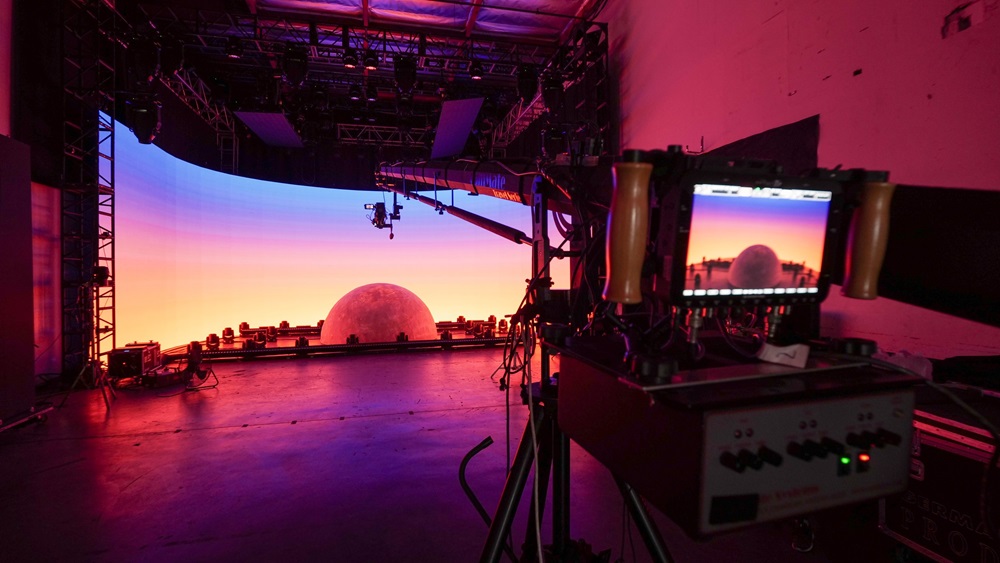Green Screen vs. XR Stage LED Wall
Will green screens be replaced by XR Stage LED walls? We are witnessing a shift in video production from green screens to LED walls in film and TV scenes, where virtual production creates vivid, dynamic backgrounds. Are you interested in this new technology for its simplicity and cost-effectiveness? Extended Reality (XR) is cutting-edge technology for film, TV, and live events.
In a studio environment, XR allows production teams to deliver augmented and mixed reality. Mixed Reality (MR) combines camera tracking and real-time rendering, creating immersive virtual worlds that can be seen live on set and captured in-camera. MR lets actors interact with virtual environments using high-resolution LED panels or projection surfaces in the room. Thanks to camera tracking, the content on these panels is generated in real-time and presented from the camera’s perspective.
Virtual Production
As the name suggests, virtual production uses virtual reality and gaming technology to create shots for TV and film. It utilizes the same setup as our XR studio but with virtual scenes used for filmmaking instead of events.
What is XR and How Does it Work?
Extended Reality, or XR, bridges augmented reality and virtual reality. The technology expands virtual scenes beyond the LED volume, which consists of an enclosed space made of LED tiles in XR studios. This immersive XR stage replaces physical sets, creating an extended reality setting that offers a dynamic experience. The scenes are produced using real-time software or game engines like Notch or Unreal Engine. This technology dynamically generates content on the screens based on the camera’s perspective, meaning the visuals shift as the camera moves.
Why Choose an Immersive XR Stage LED Wall?
Truly Immersive Production: Create rich virtual environments that immerse talent in an MR setting, offering broadcasters and production companies a lifelike environment for faster creative decisions and engaging content. MR allows versatile studio setups that adapt to any show and camera arrangement.
Real-Time Content Changes and Seamless Camera Tracking: LED displays offer realistic reflections and refractions, enabling DPs and cameramen to explore environments live in-camera, speeding up workflows. It’s like handling post-production in pre-production, allowing you to plan shots and visualize exactly what you want on-screen.
No Chroma Keying or Spill: Traditional chroma keying often lacks realism and involves costly post-production work, but XR stages eliminate the need for chroma keying. XR stages significantly speed up camera tracking system calibration and increase efficiency across multiple scene setups.
Affordable and Safe: XR stages generate various scenes without the need for on-location shoots, saving costs on location rentals. Especially in the context of social distancing and COVID-19, virtual environments provide a safe way to keep cast and crew secure in a controlled setting, reducing the need for extensive personnel on set.
How to Build an XR Stage LED Wall
While building an LED panel isn’t difficult, creating one that meets the quality and reliability required for media and filmmakers is a different story. A virtual production system isn’t something you can buy off the shelf. Building an LED panel requires in-depth knowledge of all involved functions and elements—an LED screen is far more than what meets the eye.
Versatile LED Displays: Multiple Applications
“One LED screen, many functions.” The goal is to reduce the overall number of devices by allowing a single unit to perform multiple tasks. LED posters, rental LED walls, LED dance floors, and XR stage LED walls can all serve multiple purposes.
Fine Pixel Pitch LED
Pixel pitch is a key factor in the type of shot or photo you’re producing. The closer the pixel pitch, the more close-up shots you can achieve. However, keep in mind that smaller pixel pitches emit less light, affecting your scene’s overall brightness.
The screen’s refresh rate also influences visual quality. The greater the difference between the LED screen and camera’s refresh rates, the harder it is for the camera to detect. While high frame rates are ideal, especially for fast-paced content, there are still limitations in content rendering. Even though LED panels can display 120 frames per second, renderers may struggle to keep up.
Broadcast-Grade LED Displays
Broadcast-level refresh rates are essential. Virtual stage production success relies on syncing input sources with the camera for smooth playback. “Syncing the camera with the LED is a precise, time-consuming process. If they’re out of sync, you’ll encounter visual issues like ghosting, flickering, and distortion. We ensure lock-step sync down to the nanosecond.”
Wide Gamut Color Accuracy
Maintaining consistent color rendering across different viewing angles is key to making virtual visuals realistic. We fine-tune the color science of the LED volume to fit the unique needs of each project’s sensors and DPs. We monitor each LED’s raw data and work closely with companies like ARRI to deliver precise results.
As an LED screen designer and manufacturer, Hot Electronics has been supplying this technology to rental companies for film and TV production for many years.
Post time: Sep-10-2024

